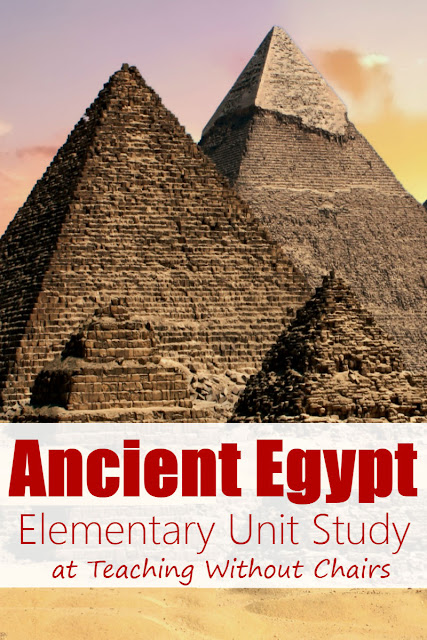Mystery of the Stolen Amulet (Ancient Egypt Homeschool Unit Study Day 1)
The Mystery of the Stolen Amulet is Day 1 in the Ancient Egyptian Class or Unit Study for homeschoolers. This lesson is designed for children who can read, and is probably most appropriate for kids in grades 3-6.
Ancient Egypt Unit Study Day 1:
Mystery of the Stolen Amulet
Length: 40-70 minutes (Our homeschool co-op class was 60 minutes long, but we could have used an extra ten minutes. If you have a shorter class you can skip the necklace activity or send it home with the kids.)
Goals: Students will use logic skills to solve an ancient Egyptian themed mystery, learn about amulets and jewelry and their importance in ancient Egyptian culture, and make their own necklace.
Lesson Outline (details below):
1- Welcome & Intro
2- Mystery of the Stolen Amulet Activity
3- Amulet Discussion
4- Necklace Activity
Supplies:
** chest or box
** scarab amulet or picture (I made a scarab amulet with leftover Sculpey clay, but you could also use saltdough or just print a picture of a scarab)
** printable Mystery of the Stolen Amulet Activity (see "c" in preparation below for free printable)
** beads and necklace string (see alternative in part 4 below)
** (optional) pictures of ancient Egyptian necklaces and collars
** (optional, but super fun) archaeology hat
Detailed Lesson:
Preparation:
a- Make or print a scarab amulet.
b- Place the amulet, pictures of ancient Egyptian necklaces and collars, and necklace-making supplies in the chest or box. Hide the chest or box.
c- Print the Mystery of the Stolen Amulet Activity (Click here for the free printable! Please link to THIS BLOG POST when you share this activity, and not the actual download page. Email me with questions!! Thank you!!). You have a couple options with this activity...if you want to ask your children to only discover who the thief was, you only need the clues relevant to the thieves. If you want your children to figure out the thief AND decipher the hiding place of the chest (highly recommended!) you will either need to make your own code page or use the one in the file. The code in the file is on 4 pages and needs to be assembled. It leads children to the "trash by the church." You can easily make your own coded location by using the code decipher included (where 1=a, 2=b, etc.). I did NOT include the decipher for my kids...I think the code is easy enough that upper elementary kids can guess it and figure it out...and they did! If I were working exclusively with younger elementary (k-2nd) who can read, I would have included the decipher as one of the hidden clues.
d- Hide the clues in the printable. We met in a classroom at a church, so I taped all the clues under chairs in the classroom. Alternatively, you can always just hand the clues to your kids...I just think it's more fun for them to collect them!
Lesson (with your kiddos!):
1- (With an archaeology hat on and lots of dramatic flair...) Tell your kiddos, "Thank you for coming all the way to Egypt! We have been trying to put together the perfect team of detectives to solve our little embarrassing problem here...as you know, amulets were a very important part of ancient Egyptian life...everybody wore them, and most of them were blessed by ancient priests because they believed it could help protect the person who wore them. Blessed amulets were even put on mummies! I'm sure you also know that while many amulets were simple circles and rectangles, many were also special shapes that reminded the Egyptians of different aspects of their religion. One of the very special amulet shapes was a scarab beetle. Now I know scarabs are a little gross to you, since they like to roll balls of dung around, but they were amazing to the ancient Egyptians! The way they push their dung across the ground reminded them of their Sun God pushing the sun across the sky. Scarabs also represent life and resurrection because after they lay their eggs in the ball of dung, lots of little scarabs emerge from the dung, full of life and energy! The ancient Egyptians also believed that their priests "charmed" the amulets with magic that would ward off evil and protect the person who wore it!
"Anyway, one of our most famous scarab amulets, the great Rainbow Scarab, was on display at our museum this week...but it was stolen! We have tried to keep its disappearance a secret, but we really need to find it soon...and figure out who stole it! We are soooo grateful that you are willing to help us figure this out! You have complete access to all the clues we've found (they might be "hidden" under your chairs...) and are welcome to use any of our resources you need! So get to work!!"
Let your kiddos gather the clues, analyze the hints, and decipher the location. Do your best not to help!!
(ANSWERS: Paul the Pirate stole the rainbow scarab. {Sarah doesn't have black shoes, Jenny was in the diamond room the whole time, and Artie left the museum before the theft occurred.} If you use the clues in the printable, the solution reads: "chest behind church trash can."
2- Discuss how they went through the problem solving process, and what they think about the scarabs (also known as dung beetles). What worked well, and what could they have done better? Tell them that the Rosetta Stone was found in 1799 with a decree from 196 BC written in both ancient Egyptian heiroglyphics and ancient Greek. Using the stone has helped archeologists figure out what ancient Egyptian heiroglyphics mean!
3- Tell your kids, "Amulets were often hung on necklaces and placed in tombs years before wealthy ancient Egyptians died...it was important to them to prepare for their death by getting their tomb ready in advance! They also believed that you continue to live after your death, so they wanted helpful amulets in their tomb to keep them safe and guide them in the afterlife. We've even found paintings on walls of tombs of army generals showing off special golden necklaces or amulets that they received as a gift from Pharaoh! The fun thing about the necklaces, though, is that they were made from everything from bones, shells, glass, and wooden beads to gold, precious metals, and expensive gems. Everyone could afford a necklace!! Here are some pictures of some of the ancient Egyptian necklaces archaeologists have discovered in tombs. We're going to wrap up today by making our own necklaces with the beads and supplies in the chest...(with your Egyptian archaeologist flair...) as a thank you for solving our mystery, you can keep all the other treasures in the chest!"
(Note: you can provide salt dough or Sculpey if you want to let your kiddos make their own amulets as well...we didn't have enough time for that, so I just used beads.)
Let everyone make necklaces!
4- Review what they've learned and their favorite parts of the day.
Did you enjoy this lesson? I'd love to hear from you!!
Click here for the rest of the Ancient Egyptian Unit Study / Class! Alternatively, you can buy the entire set here on TpT.
And if you're looking for more homeschool unit studies, be sure to check out our growing collection here!
Happy Educating,
Carla & the kids who don't sit still!

















0 comments